Christmas Eve Decorations in 19th century Brisbane: Transforming the city into a living forest
By Christina Ealing-Goldbold, Research Librarian, Library and Client Services | 17 December 2022
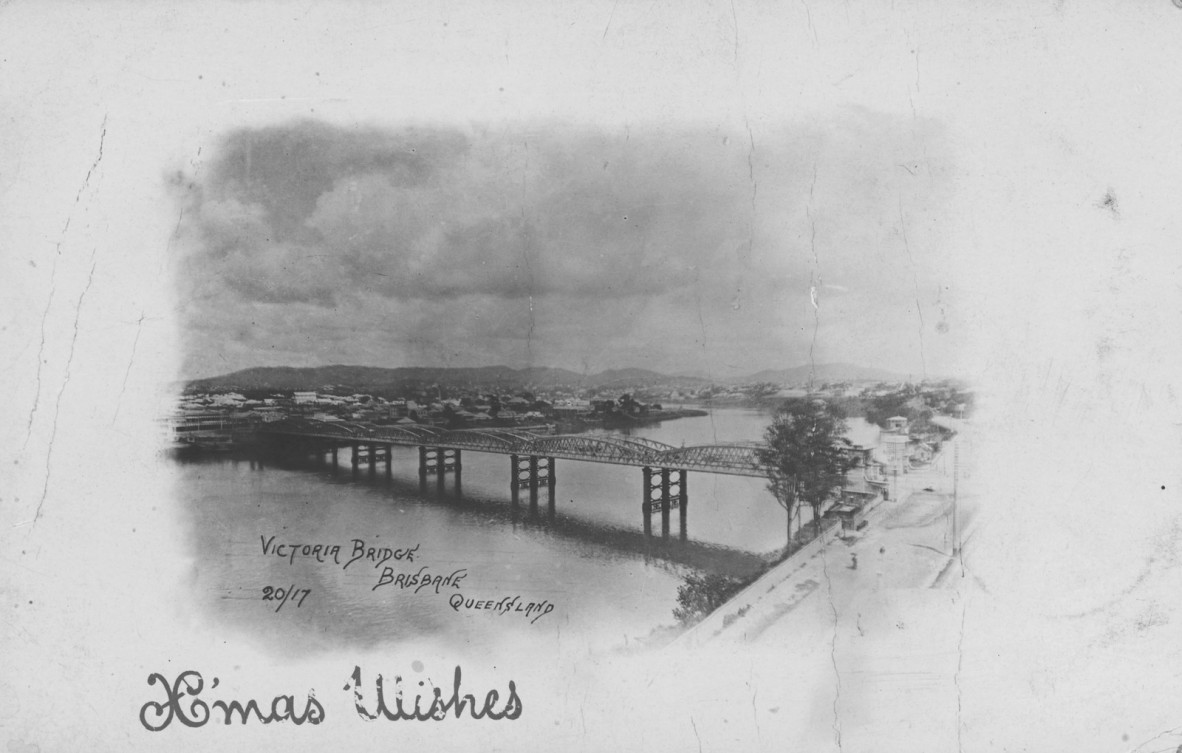
Xmas Wishes. Victoria Bridge John Oxley Library, State Library of Queensland https://hdl.handle.net/10462/deriv/138084
It is Christmas Eve in Brisbane Town - the city has been decorated with greenery as church bells ring out and shoppers dash to make their purchases!
A recent visitor to the John Oxley Library enquiring about whether this type of decoration was actually used piqued our interest and required further investigation.
In 19th and early 20th century Brisbane, Christmas was a time to decorate the city streets, with palms, gum trees and greenery. Greenery was the key to festive decorations, both in the street, in the home and on the food table. Christmas windows, filled with glittering and colourful items drew the crowds inside the stores, open until 10pm on the Eve before Christmas. On the street, customers wished each other the compliments of the season under the verandahs and in between the greenery attached to every post and pole.
Newspaper journalists gave vivid descriptions of Christmas Eve shopping in the city. As early as 1876, the observer has noticed that many “giants of the forest” had lost their arms and branches to decorate the city. As late as 1920, Greenery is still the key to street decorations:
Everywhere an available spot was found there were large bushes or branches of green trees: verandah posts became transformed into a living forest.

CHRISTMAS IN BRISBANE. (1876, December 30). The Week (Brisbane, Qld. : 1876 - 1934), p. 18. Retrieved December 16, 2022, from http://nla.gov.au/nla.news-article185003387
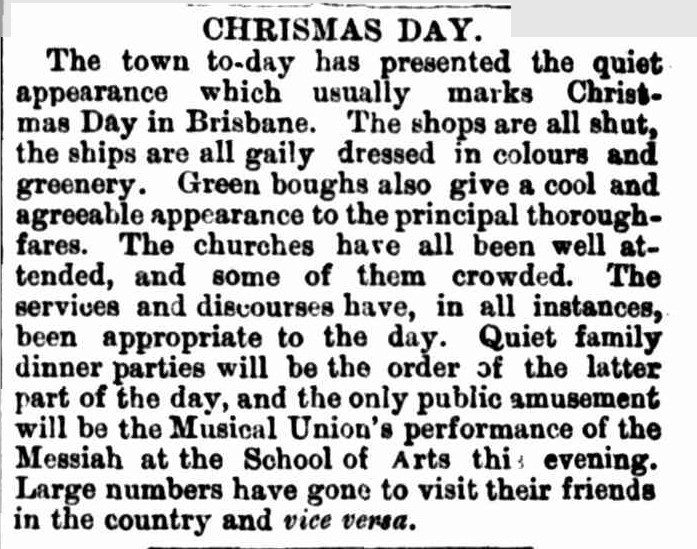
CHRISTMAS DAY. (1877, December 25). The Telegraph (Brisbane, Qld. : 1872 - 1947), p. 2. Retrieved December 16, 2022, from http://nla.gov.au/nla.news-article169498470
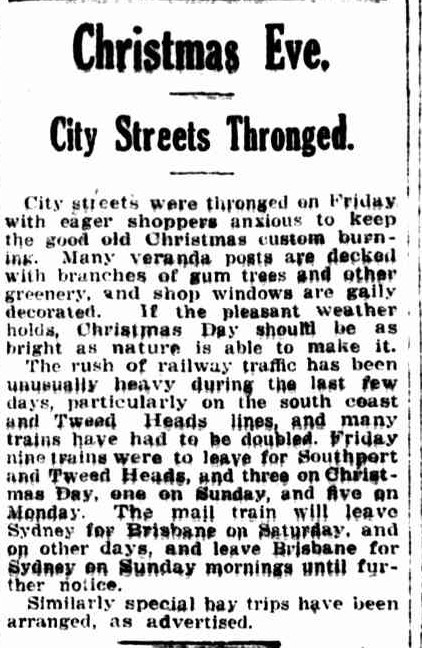
Christmas Eve. (1920, December 27). The Telegraph (Brisbane, Qld. : 1872 - 1947), p. 2. Retrieved December 16, 2022, from http://nla.gov.au/nla.news-article179632692
Early street lighting, firstly gas and later electric lamps bounced off the branches, especially effective in rainy weather. As rain fell, and the light emanated from shop windows, the droplets on the tree branches shone like tinsel and
a million crystal drops scintillated with borrowed light from the shop fronts
Not all observers or journalists were fans of the tradition of lining the streets with shrubbery, as one journalist noted in his Christmas Eve report of 1896 –
A sweltering sun…quickly dried up the monotonous array of gum boughs misnamed “decorations”
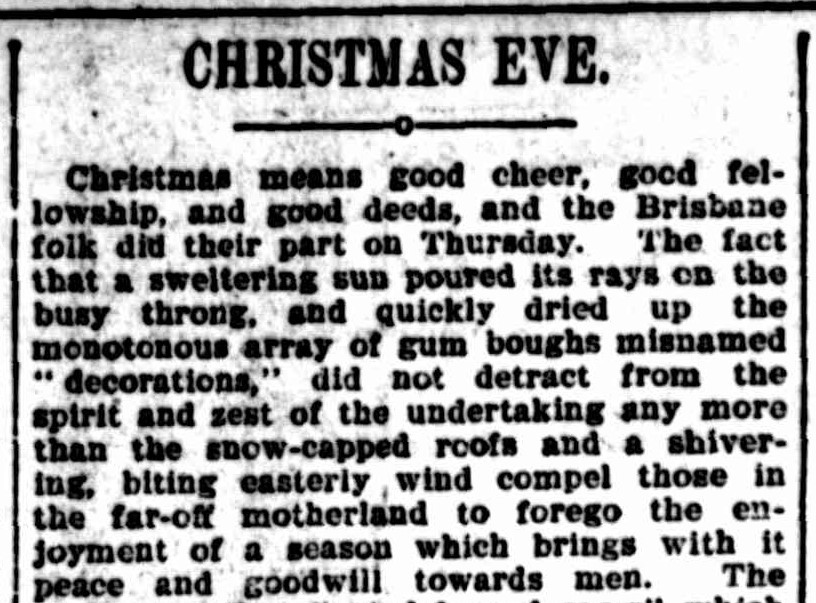
CHRISTMAS EVE. (1896, December 26). The Brisbane Courier (Qld. : 1864 - 1933), p. 4. Retrieved December 16, 2022, from http://nla.gov.au/nla.news-article3642329
Decorations for Royal Visits and other celebrations also saw the use of trees and palms along Queen Street. Elsewhere in the state, pine branches and greenery decorated the towns for both Christmas celebrations and special events and visits – from Roma and Dalby, to Toowoomba and as far north as Townsville.
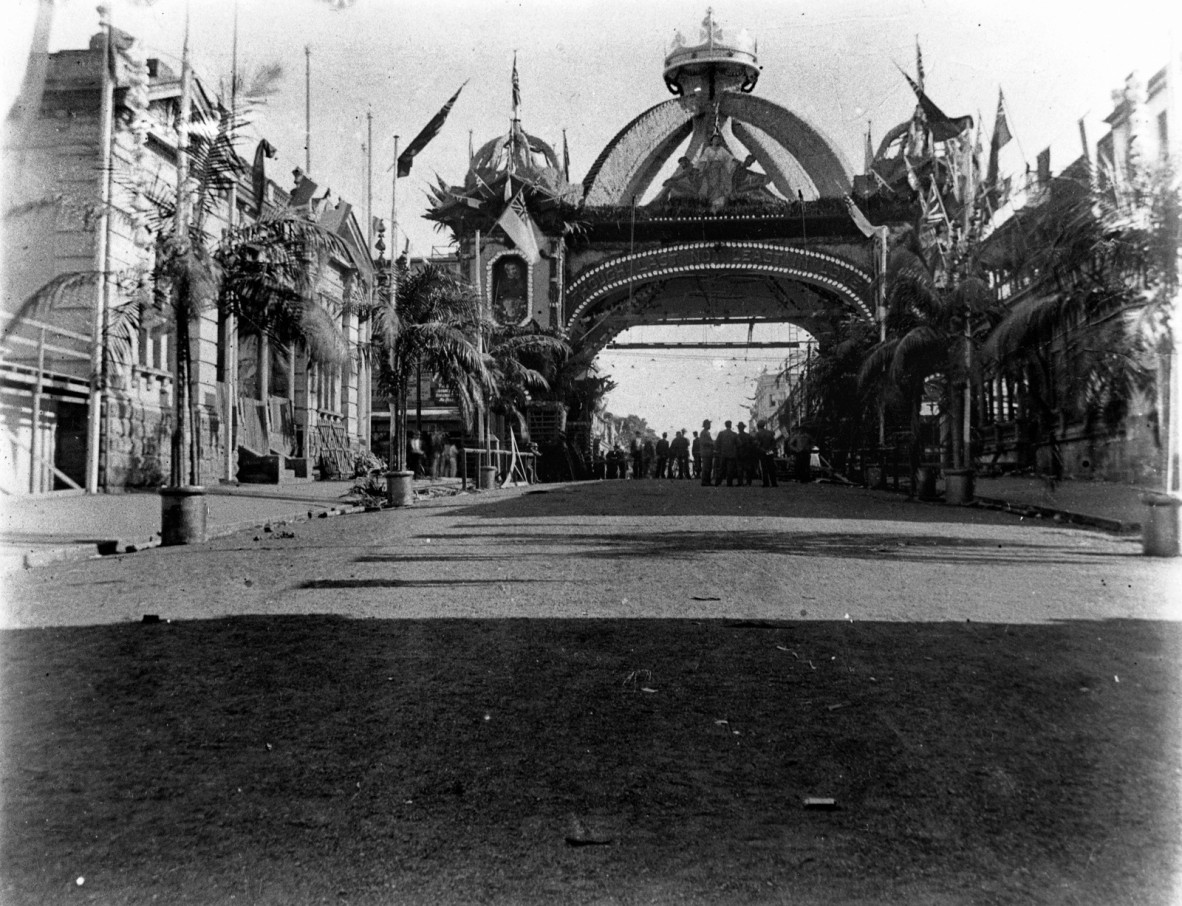
Ceremonial arch decorating Brisbane for the visit of the Duke and Duchess of York and Cornwall, May 1901 https://hdl.handle.net/10462/deriv/110231
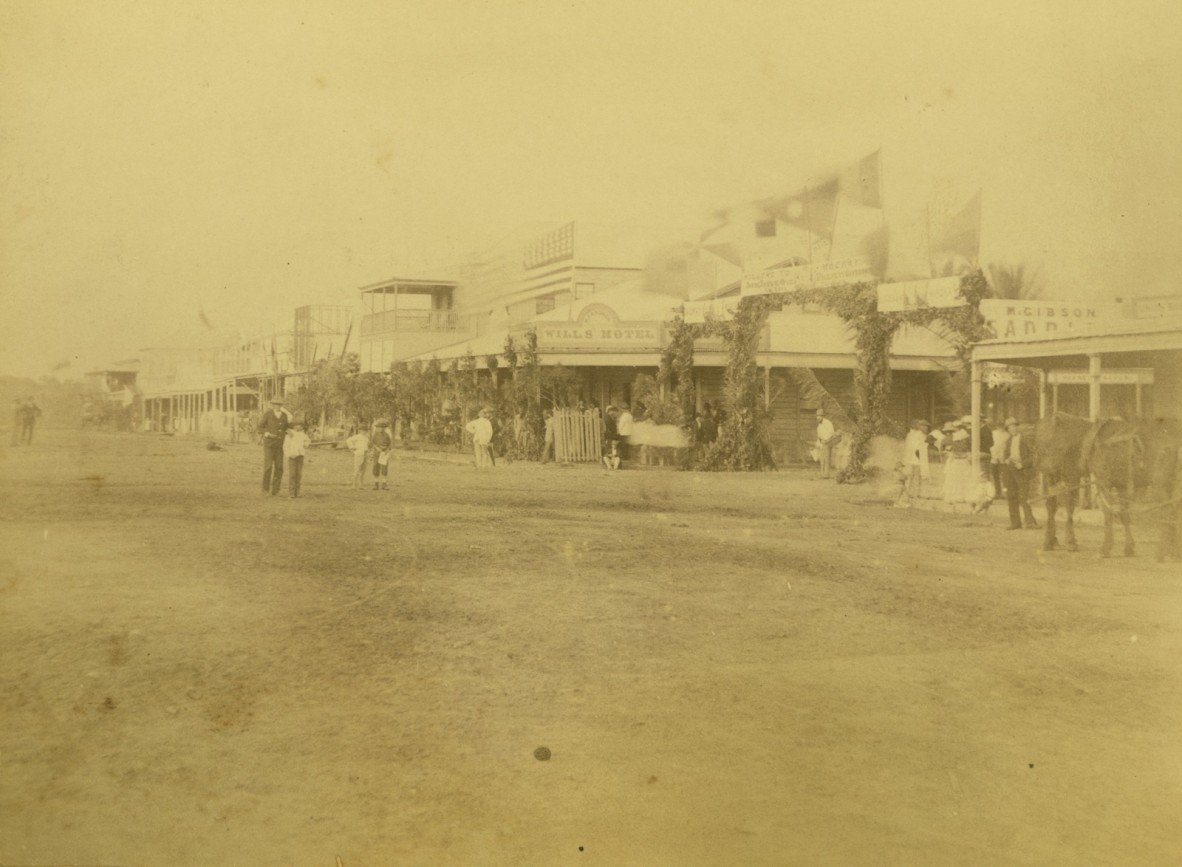
Decorations in Mackay for the visit of the Queensland Governor, Sir Anthony Musgrave in December 1883 http://hdl.handle.net/10462/deriv/119505
The Christmas greenery tradition was also used in churches and homes in readiness for Christmas Day. Some suggested that the use of greenery for decoration may have pagan origins. In some parts of Britain, the greenery (usually holly and ivy) was kept on the walls until Shrove Tuesday after which it was used as fuel to fry the pancakes.
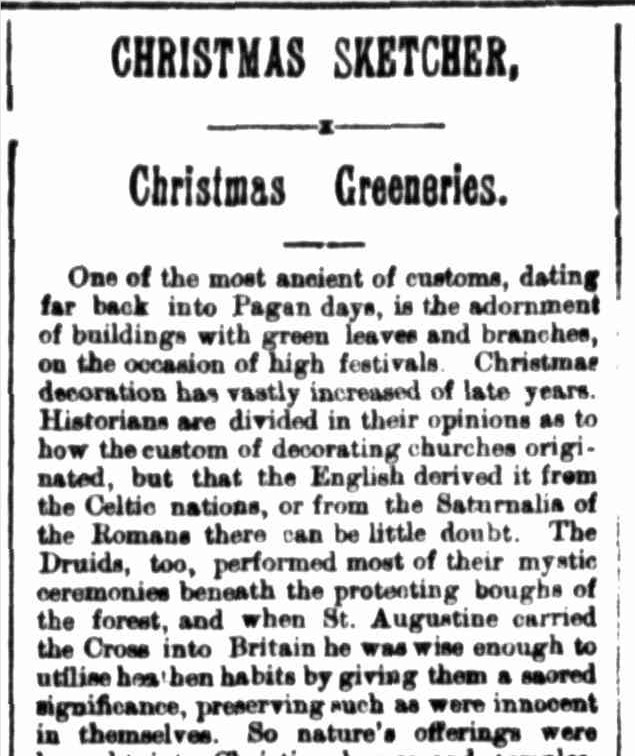
CHRISTMAS SKETCHER, (1894, December 22). Warwick Examiner and Times (Qld. : 1867 - 1919), p. 4 (CHRISTMAS SUPPLEMENT TO THE WARWICK EXAMINER & TIMES). Retrieved December 16, 2022, from http://nla.gov.au/nla.news-article82229323
“The Queenslander” of 1901 provided instructions on how best to decorate your home with greenery, suggesting
We must get in the sweet-scented wattle, the large bracken ferns and the drooping mistletoe.
However, this tradition was waning by the 1930s as was reported in The Dalby Herald in 1932 and had vanished almost entirely after World War Two.
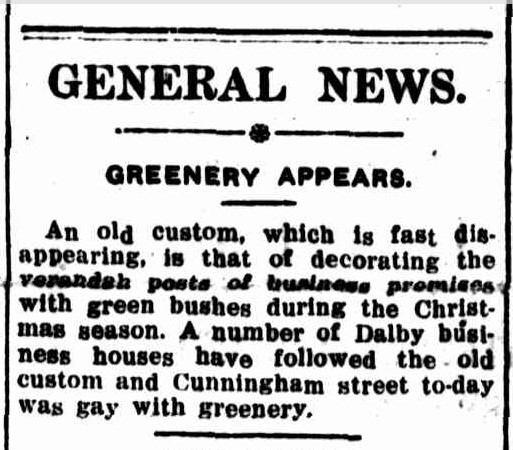
GENERAL NEWS. (1932, December 23). The Dalby Herald (Qld. : 1910 - 1954), p. 2. Retrieved December 16, 2022, from http://nla.gov.au/nla.news-article217521371
When decorating your home for Christmas, think of the earlier Queensland traditions of using trees and shrubs to provide a cool and festive air.
If you’ve heard a story about early Queensland that you’d like to investigate further, why not Ask a Librarian online, or visit us in person over the Christmas period.
Further Reading on Christmas Traditions
Blogs
“Exquisite Absurdity” | State Library Of Queensland (slq.qld.gov.au)
The absurdity of the hot Christmas dinner in a tropical climate.
Christmas and the Magic of Toys from our Childhood | State Library Of Queensland (slq.qld.gov.au)
Early Australian toys that bring back memories of Christmas delights under the tree in the 1930s and 1940s.
Journal Articles
Eldridge, A., & Pappalepore, I. (2019). Festive Space and Dream Worlds: Christmas in London. In A. Smith & A. Graham (Eds.), Destination London: The Expansion of the Visitor Economy (pp. 183–204). University of Westminster Press.
Lewis, T. (2005). Undecking the Halls: Why Christmas Decorations Do Not Belong in Public Library Spaces. Australasian Public Libraries and Information Services, 18(4), 137–140.
Paton, C. I. (1947). The Burning of the Christmas Decorations. Folklore, 58(1), 239–239.
Scharer, L. L. (1980). Christmas Past: How to Decorate Your Historical Tree. History News, 35(12), 9–11.
Zakreski, Patricia. “The Victorian Christmas Card as Aesthetic Object: ‘Very Interesting Ephemeræ of a Very Interesting Period in English Art-Production.’” Journal of Design History 29, no. 2 (2016): 120–36.
Books
Auld, W. (1968). Christmas traditions. Gale Research Co.
Aurell, B. (2018). Scandikitchen Christmas : Recipes and traditions from Scandinavia. Ryland Peters & Small.
Brasch, R. (1994). Christmas customs & traditions : why we do what we do at Christmas. Angus & Robertson.
Kostyal, K.M. & Epstein, L. (2011). Christmas in Williamsburg 300 years of family traditions. National Geographic.
Miles, C. (1968). Christmas in ritual and tradition, Christian and pagan. T.F. Unwin.
O’Neil, S. (1981). The gift of Christmas past : a return to Victorian traditions. American association for State and Local History.
Comments
Your email address will not be published.
We welcome relevant, respectful comments.